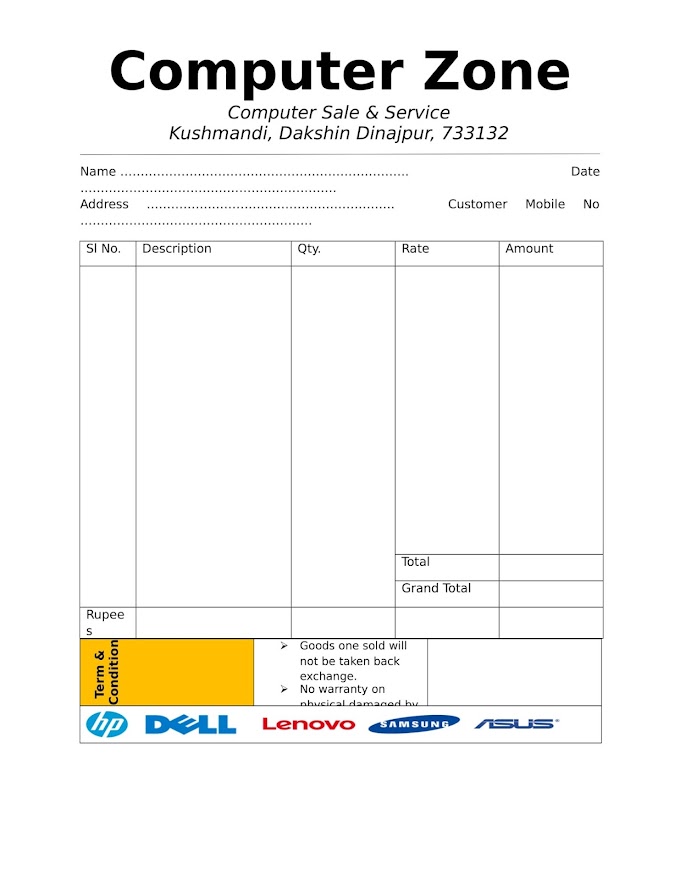DOS-Disk Operating System
What is Booting?
It is procedure by which we can ready the computer to do any task according to our choice.Booting are two types:
- Hot Booting (Worm Booting)
- Cold Booting (Cool Booting)
Cold Booting:-
When the machine is off and we boot the machine by pressing
power switch from switch board and then on the power switch of CPU box, this
type of booting is called cold Booting.
Hot Booting:-
When the machine is on and we reboot the machine by pressing Ctrl+Alt+Del switch at a time from keyboard or by pressing RESET switch from CPU box,this type of booting is called Hot Booting.
What is DOS?
The very first operating system used on the earliest IBM PCs was called simply the Disk Operating System,abbreviate DOS.
DOS(Disk Operating System) is an acronym for several closely related operating systems that dominated the IBM PC compatible market between 1981 and 1995, or until about 2000 including the partially DOS-based Microsoft Windows versions 95, 98, and Millennium Edition.
Related systems include MS-DOS, PC DOS, DR-DOS, FreeDOS, ROM-DOS, and PTS-DOS
Command:-
Command is a set of instruction.There are mainly two types of DOS command
- Internal Command
- External Command
Internal Command:-
These commands are automatically loaded into the computer's memory during booting process.They are actually included into the Command.com file.These commands are executable immediately after DOS prompt.
System Prompt or DOS Prompt:
C:\> This is called system prompt.
Note:-Where C is drive name and '\' symbol means back slash.
Example of some Internal command-Date,Time,Ver,Vol,Cls,Type,Copy con,Copy,Ren,Del,MD,CD etc.
External Command:-
These commands are meant for special purposes.These are found in separate files on Hard disk or Floppy Disk,so that they don't typically consume valuable memory space.They are loaded into memory only as called that specifies command name.This are also called Disk-Resident commands.
Example of some External Commands-Attrib,Chkdsk,Label,FC,Xcopy,Move,Mode,Mem,More,Sort,Find,Tree,Help,Edit etc.
Some Important Internal and External DOS commands
Copy Con
(Internal)
syntax:-C:\>Copy con (File Name)<Enter>
This Command is used to make a new file
TYPE
(Internal)
Syntex:-C:\>Type [target drive:path\file name] <Enter>
This command is used to view the content of any file.
APPEND
(External)
APPEND ;
APPEND [d:]path[;][d:]path[...]
APPEND [/X:on|off][/path:on|off] [/E]
Displays or sets the search path for data files. DOS will search the specified
path(s) if the file is not found in the current path.
ASSIGN
(External)
ASSIGN x=y [...] /sta
Redirects disk drive requests to a different drive.
ATTRIB
(External)
ATTRIB [d:][path]filename [/S]
ATTRIB [+R|-R] [+A|-A] [+S|-S] [+H|-H] [d:][path]filename [/S]
Sets or displays the read-only, archive, system, and hidden attributes of a
file or directory.
BACKUP
(External)
BACKUP d:[path][filename] d:[/S][/M][/A][/F:(size)] [/P][/D:date] [/T:time]
[/L:[path]filename]
Makes a backup copy of one or more files. (In DOS Version 6, this program is
stored on the DOS supplemental disk.)
BREAK
(Internal)
BREAK =on|off
Used from the DOS prompt or in a batch file or in the CONFIG.SYS file to set
(or display) whether or not DOS should check for a Ctrl + Break key
combination.
CALL
(Internal)
CALL [d:][path]batchfilename [options]
Calls another batch file and then returns to current batch file to continue.
CHDIR
(Internal)
CHDIR (CD) [d:]path
CHDIR (CD)[..]
Displays working (current) directory and/or changes to a different directory.
CHKDSK
(External)
CHKDSK [d:][path][filename] [/F][/V]
Checks a disk and provides a file and memory status report.
CHOICE
(Internal)
CHOICE [/C[:]keys] [/N][/S][/T[:]c,nn] [text]
Used to provide a prompt so that a user can make a choice while a batch program
is running.
CLS (Clear Screen)
(Internal)
CLS
Clears (erases) the screen.
COMMAND
(External)
COMMAND [d:][path] [device] [/P][/E:(size)] [/MSG][/Y [/C (command)|/K
(command)]
Starts a new version of the DOS command processor (the program that loads the
DOS Internal programs).
COPY
(Internal)
COPY [/Y|-Y] [/A][/B] [d:][path]filename [/A][/B] [d:][path][filename] [/V]
or
COPY [/Y|-Y][/A][/B] [d:][path]filename+[d:][path]filename[...][d:][path][filename]
[/V]
Copies and appends files.
DATE
(Internal)
DATE mm-dd-yy
Displays and/or sets the system date.
TIME
(Internal)
Syntax:-C:\>Time<Enter>
Show the system Time ,then you can set new time or can exit by pressing Enter if you don't want to change.
DEBUG
(External)
DEBUG [pathname] [parameters]
An MS-DOS utility used to test and edit programs.
DEFRAG
(External)
DEFRAG [d:] [/F][/S[:]order] [/B][/skiphigh [/LCD|/BW|/GO] [/H]
DEFRAG [d:] [/V][/B][/skiphigh] [/LCD]|/BW|/GO] [/H]
Optimizes disk performance by reorganizing the files on the disk.
DEL (ERASE)
(Internal)
DEL (ERASE) [d:][path]filename [/P]
Deletes (erases) files from disk.
DELOLDOS
(External)
DELOLDOS [/B]
Deletes all files from previous versions of DOS after a 5.0 or 6.0
installation.
DELTREE
(External)
DELTREE [/Y] [d:]path [d:]path[...]
Deletes (erases) a directory including all files and subdirectories that are in
it.
DEVICE
(Internal)
DEVICE=(driver name)
Used in the CONFIG.SYS file to tell DOS which device driver to load.
DEVICEHIGH
(Internal)
DEVICEHIGH=(driver name)
Like DEVICE, DEVICEHIGH is used in the CONFIG.SYS file to tell DOS which device
driver software to use for devices; however, this option is used to install the
device driver into the upper memory area.
DIR
(Internal)
DIR [d:][path][filename] [/A:(attributes)] [/O:(order)]
[/B][/C][/CH][/L][/S][/P][/W]
Displays directory of files and directories stored on disk.
DISKCOMP
(External)
DISKCOMP [d:] [d:][/1][/8]
Compares the contents of two diskettes.
DISKCOPY
(External)
DISKCOPY [d:] [d:][/1][/V][/M]
Makes an exact copy of a diskette.
DOS
(Internal)
DOS=[high|low],[umb|noumb]
Used in the CONFIG.SYS file to specify the memory location for DOS. It is used
to load DOS into the upper memory area and to specify whether or not the upper
memory blocks will be used.
DOSKEY
(External)
DOSKEY [reinstall] [/bufsize=size][/macros][/history][/insert|/overstrike]
[macroname=[text]]
Loads the Doskey program into memory which can be used to recall DOS commands
so that you can edit them.
EDIT
(External)
EDIT [d:][path]filename [/B][/G][/H][/NOHI]
Starts the MS-DOS editor, a text editor used to create and edit ASCII text
files.
EXIT
(Internal)
EXIT
Exits a secondary command processor.
MEM
(External)
MEM [/program|/debug|/classify|/free|/module(name)] [/page]
Displays amount of installed and available memory, including extended,
expanded, and upper memory.
- Download Now All Complete DOS command Click Here.
- Free DOS Command Download Now
- Free DOS E-Book Visit Here
- Bangla Computer Tips Login Now












